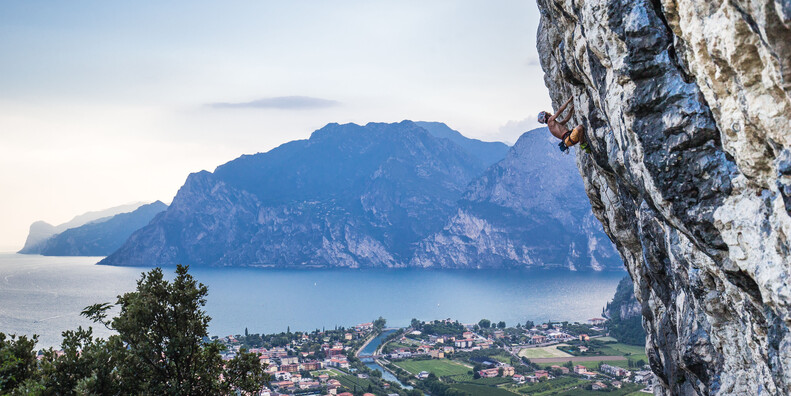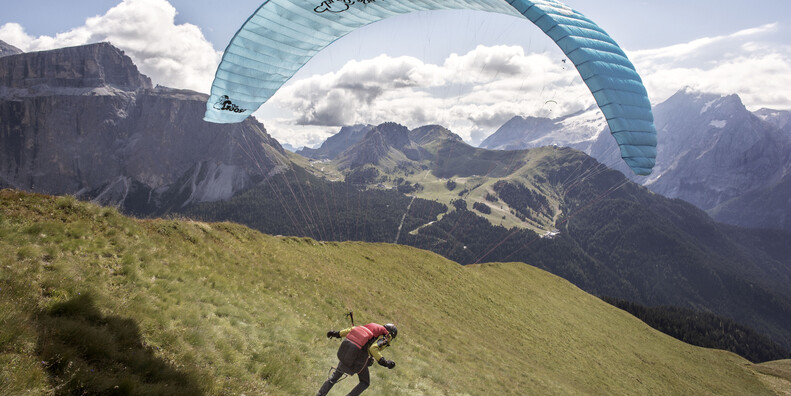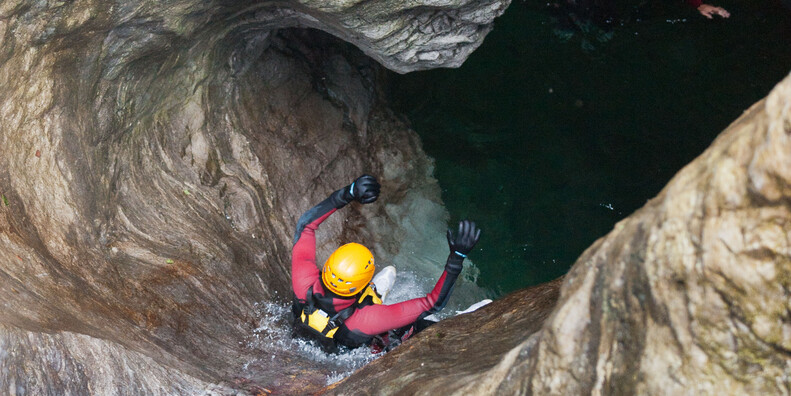GET BACK IN SHAPE WITH A TOUCH OF ADVENTURE
High in the mountains, the conditions are ideal for ski mountaineering, but it is also a great time to try other trendy activities. For sporty ones and for those who enjoy new experience, try bouldering, rock climbing, paragliding, water sports, and soft trekking
With your skis, up and down the great mountains
Skimo - the abbreviation of ski mountaineering - is historically a springtime sport. Because it is pleasant to climb high up with milder temperatures, because in this period the snow settles faster and the itineraries are safer even high up, and because - once you get to top - drawing winding trails on the thin layer of “firn” heated by the sun’s rays is the best feeling.
In springtime, you need to look for the snow high up, on more open terrain, closer to the sky, moving at first light to take advantage of the best snow conditions. There are several itineraries available: from simple ones, ideal for those who wish to try out this sport, to more challenging ones, that require suitable physical preparation and good knowledge of the winter environment. It is advisable to hire an Alpine mountain guide, and it is essential to always carry an avalanche transceiver, a spade and a probe with you.
From this point of view, Val di Sole offers a wide range of “classic” springtime trails high in the mountains. Up in the valley, you can climb to Rifugio Stavel “Francesco Denza” to ascend the Presanella. From Passo Tonale, on the other hand, you can reach the Mandròn “Città di Trento” and “Ai Caduti dell’Adamello” mountain huts for climbs to Cresta Croce and the Adamello, and for the descent from Punta Pisgana, one of the longest in the Alps. In Val di Peio, a side valley of Val di Sole, sleeping over at Rifugio Cevedale “Guido Larcher”, you can climb the Cevedale and the Palòn de la Mare.
Walking: two offers for slow tourism
Spring is the ideal time to travel these trails, designed for travellers in search of a new experience, that is moving through little known routes and territories to be explored at a slow pace, to fully appreciate their heritage, made up of art, landscape and spirituality.
From the Valle dell'Adige to the feet of the Brenta Dolomites, in search of the numerous signs man has left on the middle mountains, now partially abandoned, in order to rediscover the dimension of silence. The Sentiero San Vili is a trail conceived by SAT (Tridentine Mountaineers’ Association), about 100 Km long, that connects Trento to the Giudicarie valleys, following the footsteps of the bishop Vigilius, patron saint of Trento, along the paths and roads of the middle mountain during his evangelization of the western Trentino valleys in the Fourth century AD. With your bag on your back and your boots on your feet, you walk for five to six days among picturesque environments, observing numerous testimonies of the history and culture of the valleys you cross.
The Cammino Jacopeo d’Anaunia develops on either side of Val di Non. An ideal starting point is the Basilica of Val di Non’s Martyrs in the village of San Zeno, the religious capital of the valley, and ending at the hermitage of San Romedio. 160 Km long, it follows in 7/8 stages the paths and roads once travelled by pilgrims who left this valley to reach Santiago de Compostela. The various stages touch on the most significant places of devotion along these ancient routes: medieval churches and votive chapels, hermitages and religious spots dedicated to saints that were particularly venerated in the past, like its destination – the San Romedio hermitage - erected on a rocky spur that houses five different parishes. Farmhouse inns, hotels, and small restaurants accompany the route, marked by the “yellow scallop shell” of the Jacobean routes.
Watersports on lakes and rivers
Sailing, windsurfing, rafting, canoeing, river trekking and canyoning. As springtime arrives, the water becomes an ideal training ground for numerous exciting sports and outdoor activities, some particularly adventurous and unusual. Lake Garda needs no presentations: it is beautiful to look at, with its Mediterranean vegetation, both from its shores and from the mountains surrounding the Trentino side. But it is even more beautiful to enjoy on a windsurfing board or a dinghy, driven along by the Ora or the Pelèr - the local winds that enthusiasts the world over know well. Sailing and windsurfing schools abound in the main sailing clubs which, from March to November, organise a top level calendar of regattas, as well as the rentals that allow you to take to the water with all the right gear.
On the other hand, wild waters can be found in the river Noce between Mezzana and Mostizzolo, considered the best river in Europe to practise rafting. Onboard a large unsinkable and self-emptying inflatable, the crew of 4 to 6 people - under the rafting guide who manages the helm - join forces and energy to paddle and guide the vessel among the rapids and whirlpools to their destination. On the Noce there are numerous specialised centres that offer descents of varying lengths and difficulties.
For those who would prefer a more relaxing experience, you can try soft rafting along a section of the river Adige onboard an inflatable ferry designed for river navigation, and have more time to admire the countryside of Vallagarina from a decidedly unusual point of view. The warm spring days are ideal for paddling through the waters of the main lakes in a canoe, breaking the surface with your paddle. This is the ideal way of searching for a hidden spot or a secluded beach - otherwise inaccessible - from where to observe the landscape or the local fauna.
Following the flow of the water along rock slides, rappelling down double ropes inside a waterfall, diving and swimming in natural pools of crystal clear water and deep gorges. There is no lack of excitement when an Alpine mountain guide takes you canyoning. This is an outdoor activity that combines rock climbing techniques with the exploration of the wildest river environments. In Trentino, you can try it in areas like Lake Garda and Valle di Ledro. Another alternative is river trekking: wading, diving, sliding and travelling against the current. In particular, you can try it on the river Sarca, in the spectacular section that runs through the Limarò gorge. In the Val di Non, on the other hand, the Novella stream has created, over thousands of years, spectacular ravines cut through the rock with narrow passages and vertical walls. In this river park, you walk suspended on metal walkways just above the water, captivated by the reflections and light playing on the walls.
New spaces for climbing
Trentino is internationally renowned for rock climbing. Starting from the upper part of Lake Garda, boasting about 600 fitted and regularly checked routes on the 16 rock faces that are part of the Outdoor Park Garda Trentino-Ledro, four of which are classified as family routes. However, other territories are being added, including Val Daone, one of the gateways to the Nature Park Adamello-Brenta, among the most fascinating nature reserves in western Trentino. In its Alpine landscape dominated by water and rock and woods, there are also hundreds of blocks of rock of all shapes and sizes spread out around the bottom of the valley. Cleaned and made easily accessible thanks to foot paths and signs, they provide bouldering enthusiasts - a rock climbing speciality - the excitement of the hardest challenges just a few metres above the ground. In order to access the Boulder Park Val Daone, all you need to do is get yourself some climbing shoes, a bag of magnesite and a crash pad to protect yourself against the consequences of a possible fall, and you are ready to take on the challenge “to the last hold” against gravity and difficulty. And, still in the Giudicarie valleys, there is the “Falesia Dimenticata” [Forgotten Cliff], a historical climbing wall near San Lorenzo in Banale - Dorsino, really unique in terms of the type of rock and the aesthetics of the location. It was given back to the climbers thanks to crowdfunding (one of the first to sign up for it was Adam Ondra, the best climber in the world).
Air & water
And, after earth and water, we had to add the air element to your holiday. It’s called “Hike & Fly”, and it combines the uniqueness of climbing high in the mountains at dawn - to the meadows in Prada above San Lorenzo in Banale, at the foot of the Brenta Dolomites - with a unique paragliding flight above Lake Molveno, taking advantage of the morning heat currents that climb the slopes, and landing after a 1,100 metre drop next to the lake. And, depending on the snow conditions, the take-off point can even be on Cima Tosa - 3,136 metres asl - one of the highest peaks in the Brenta Dolomites.
Info: www.visittrentino.info/en/experience/adventure-and-adrenaline





